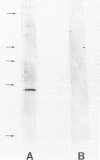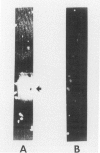Abstract
The role of plasminogen activator (PA) in the pathogenesis of acantholysis in canine pemphigus vulgaris (PV) was evaluated using differentiated cultures of canine oral keratinocytes. Both the secreted and cell-associated PA activity in cultured canine keratinocytes were completely inhibited by specific anti-urokinase antibodies. Anti-tissue type PA antibodies did not inhibit either secreted or cell-associated PA activity. Immunoblots and fibrin zymography revealed a single 57,000 molecular weight urokinase-type PA in the conditioned media of the canine oral keratinocytes. Incubation of the differentiated cultures with PV Ig resulted in a significant increased in the levels of PA activity and both canine and human PV Ig were effective at inducing acantholysis typical of that seen in the clinical disease. The addition of urokinase inhibitor to the cultures treated with PV Ig prevented the development of acantholysis. These data strongly support the conclusion that PA is involved in acantholysis which is the cardinal feature of PV.
Full text
PDF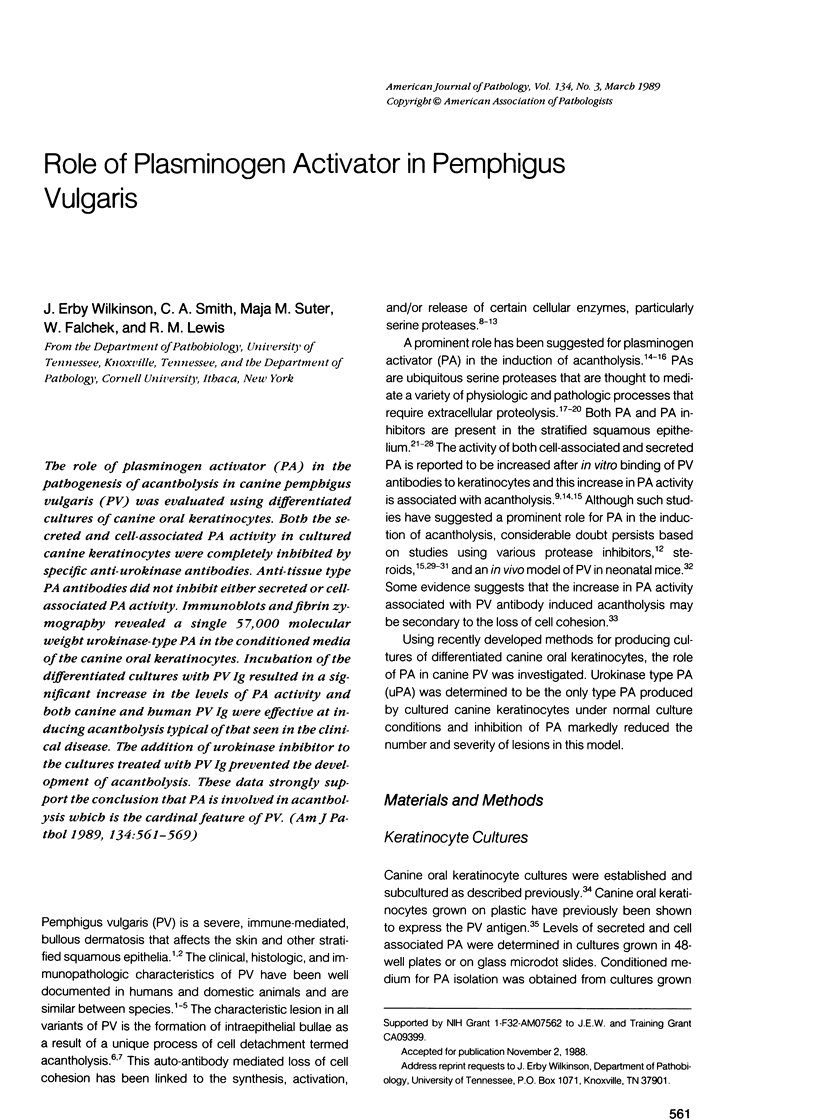
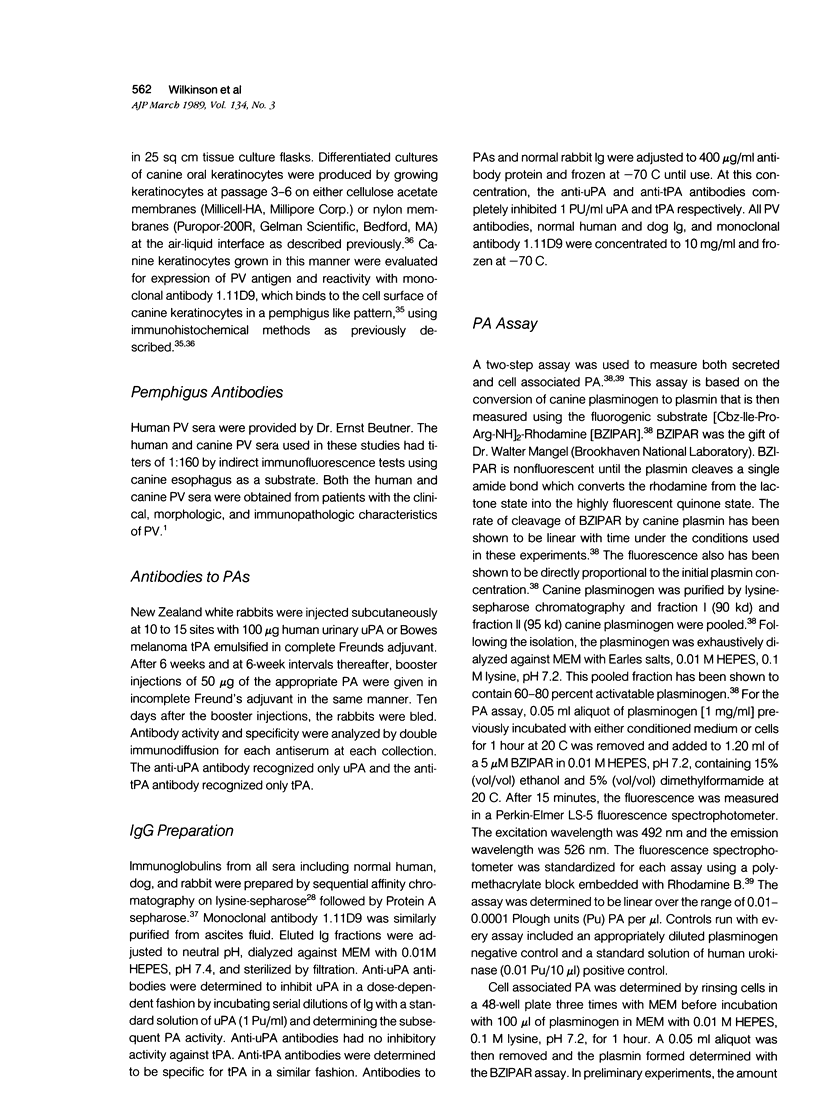
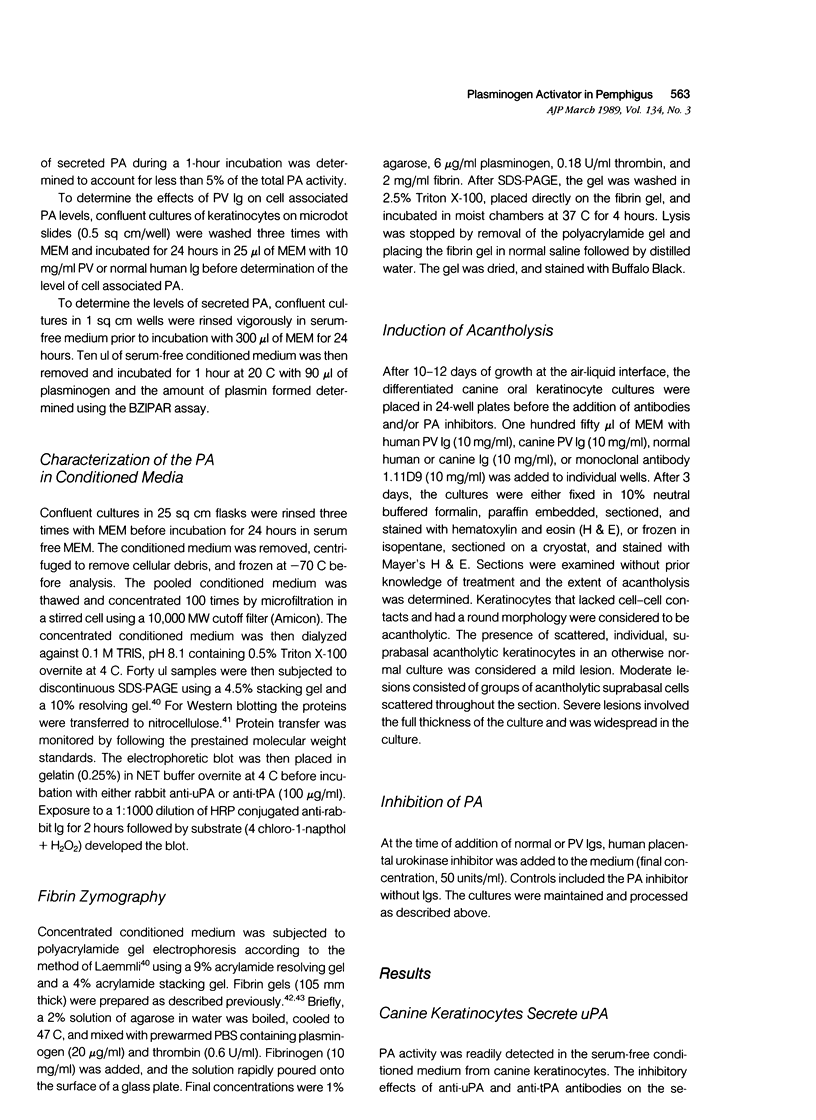
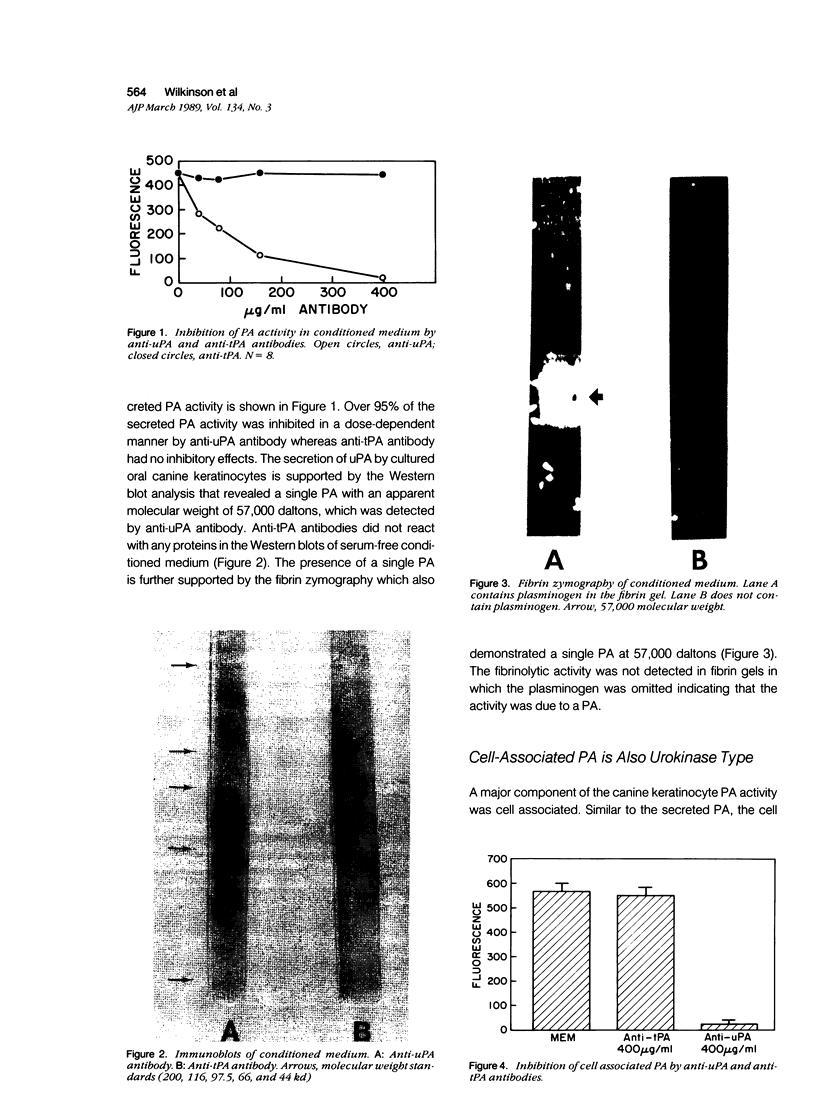
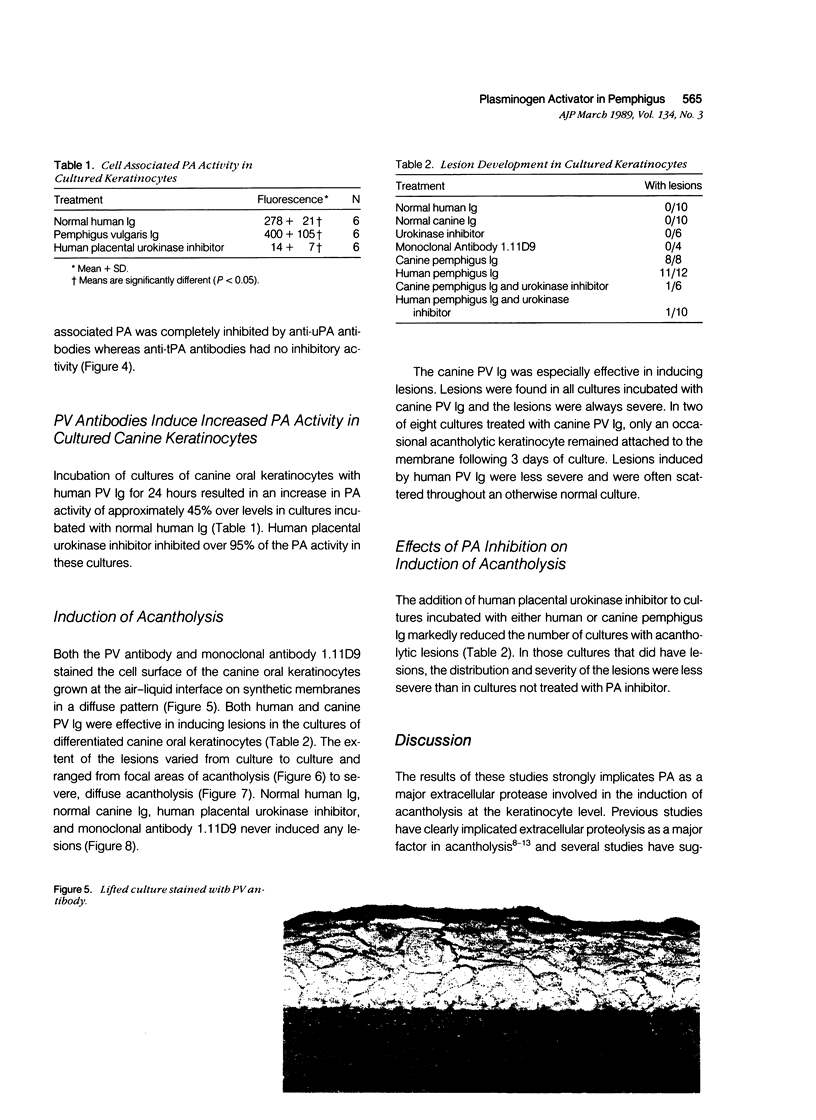
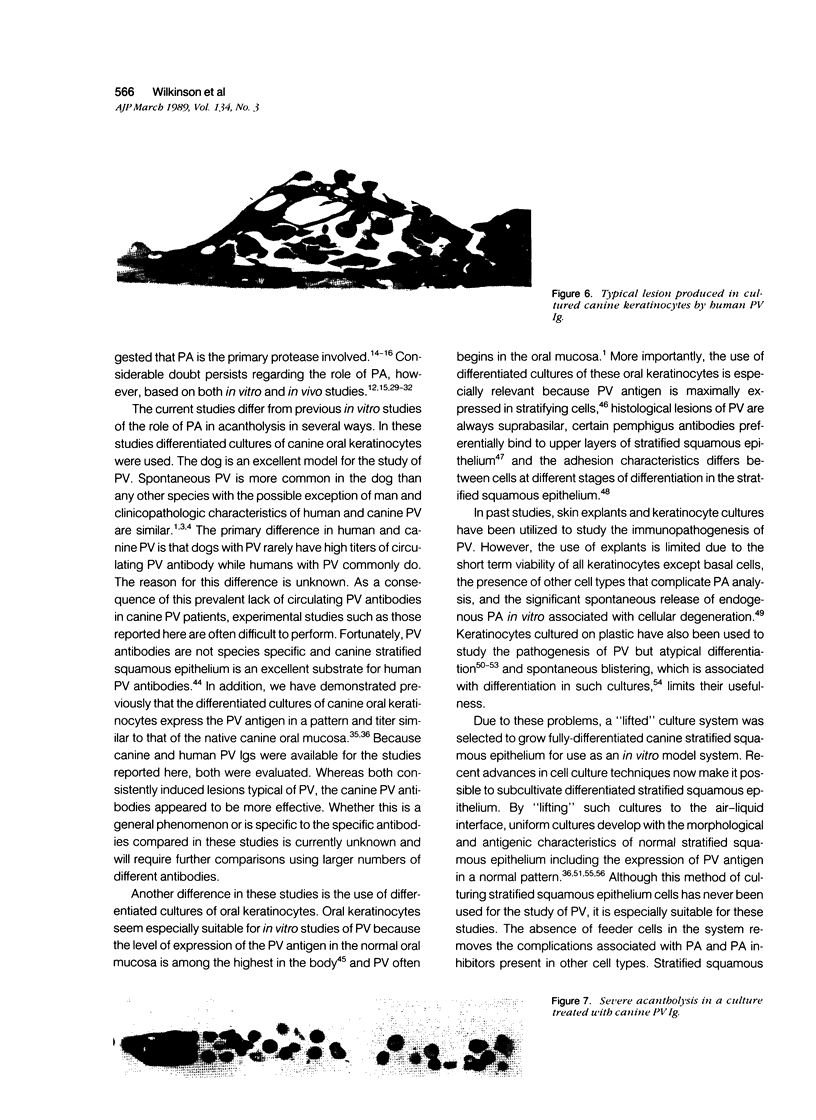
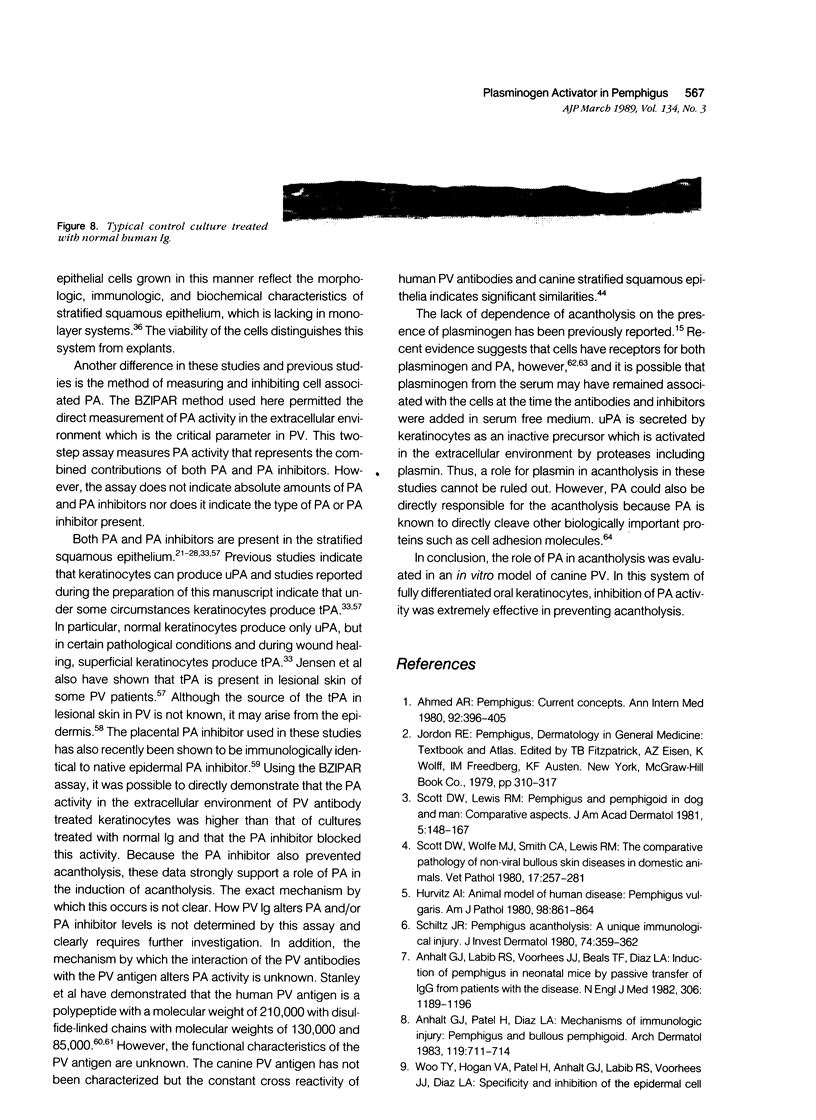
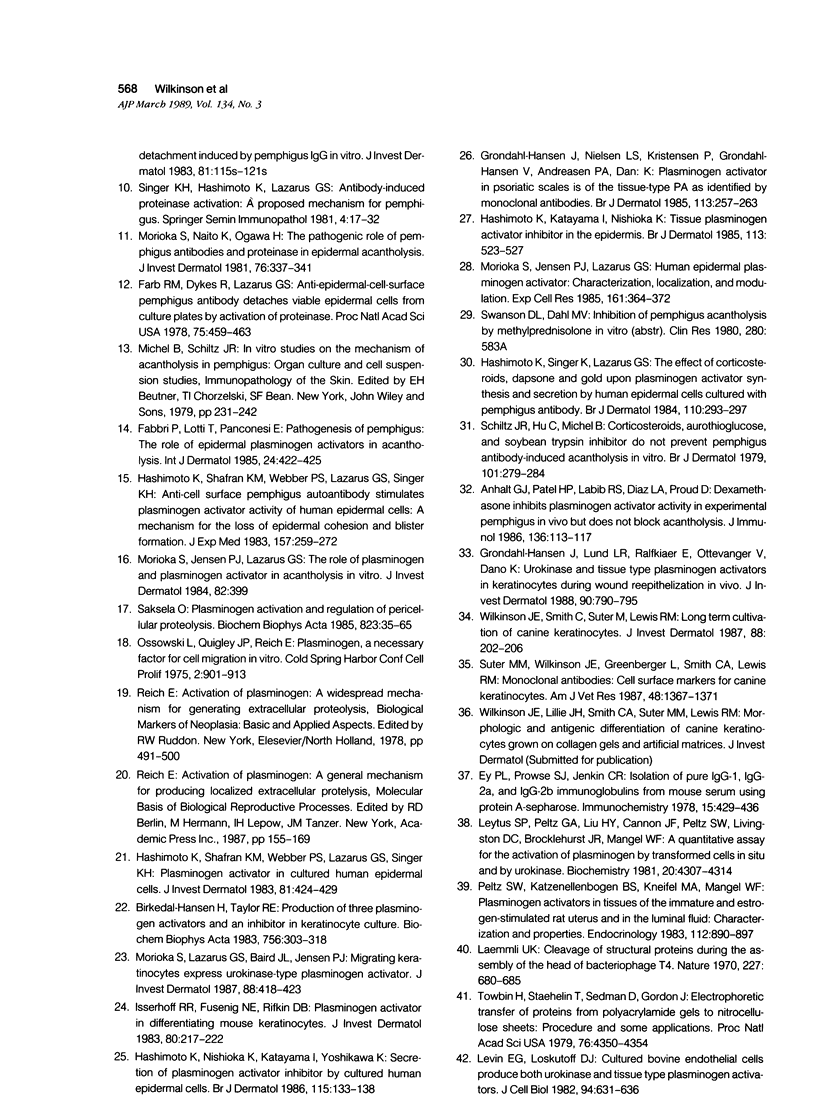
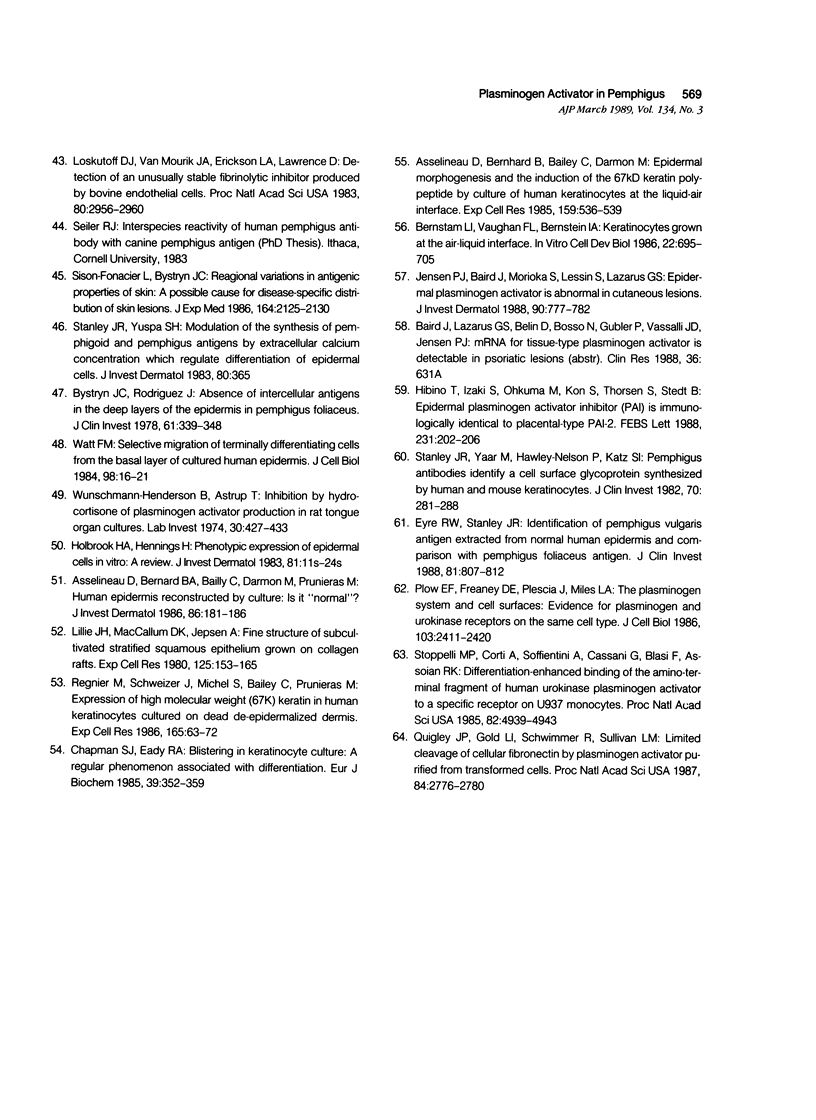
Images in this article
Selected References
These references are in PubMed. This may not be the complete list of references from this article.
- Anhalt G. J., Labib R. S., Voorhees J. J., Beals T. F., Diaz L. A. Induction of pemphigus in neonatal mice by passive transfer of IgG from patients with the disease. N Engl J Med. 1982 May 20;306(20):1189–1196. doi: 10.1056/NEJM198205203062001. [DOI] [PubMed] [Google Scholar]
- Anhalt G. J., Patel H. P., Labib R. S., Diaz L. A., Proud D. Dexamethasone inhibits plasminogen activator activity in experimental pemphigus in vivo but does not block acantholysis. J Immunol. 1986 Jan;136(1):113–117. [PubMed] [Google Scholar]
- Anhalt G. J., Patel H., Diaz L. A. Mechanisms of immunologic injury. Pemphigus and bullous pemphigoid. Arch Dermatol. 1983 Sep;119(9):711–714. [PubMed] [Google Scholar]
- Asselineau D., Bernard B. A., Bailly C., Darmon M., Pruniéras M. Human epidermis reconstructed by culture: is it "normal"? J Invest Dermatol. 1986 Feb;86(2):181–186. doi: 10.1111/1523-1747.ep12284237. [DOI] [PubMed] [Google Scholar]
- Asselineau D., Bernhard B., Bailly C., Darmon M. Epidermal morphogenesis and induction of the 67 kD keratin polypeptide by culture of human keratinocytes at the liquid-air interface. Exp Cell Res. 1985 Aug;159(2):536–539. doi: 10.1016/s0014-4827(85)80027-6. [DOI] [PubMed] [Google Scholar]
- Bernstam L. I., Vaughan F. L., Bernstein I. A. Keratinocytes grown at the air-liquid interface. In Vitro Cell Dev Biol. 1986 Dec;22(12):695–705. doi: 10.1007/BF02621086. [DOI] [PubMed] [Google Scholar]
- Birkedal-Hansen H., Taylor R. E. Production of three plasminogen activators and an inhibitor in keratinocyte cultures. Biochim Biophys Acta. 1983 Apr 20;756(3):308–318. doi: 10.1016/0304-4165(83)90339-2. [DOI] [PubMed] [Google Scholar]
- Bystryn J. C., Rodriguez J. Absence of intercellular antigens in the deep layers of the epidermis in pemphigus foliaceus. J Clin Invest. 1978 Feb;61(2):339–348. doi: 10.1172/JCI108944. [DOI] [PMC free article] [PubMed] [Google Scholar]
- Chapman S. J., Eady R. A. Blistering in keratinocyte cultures: a regular phenomenon associated with differentiation. Eur J Cell Biol. 1986 Jan;39(2):352–359. [PubMed] [Google Scholar]
- Ey P. L., Prowse S. J., Jenkin C. R. Isolation of pure IgG1, IgG2a and IgG2b immunoglobulins from mouse serum using protein A-sepharose. Immunochemistry. 1978 Jul;15(7):429–436. doi: 10.1016/0161-5890(78)90070-6. [DOI] [PubMed] [Google Scholar]
- Eyre R. W., Stanley J. R. Identification of pemphigus vulgaris antigen extracted from normal human epidermis and comparison with pemphigus foliaceus antigen. J Clin Invest. 1988 Mar;81(3):807–812. doi: 10.1172/JCI113387. [DOI] [PMC free article] [PubMed] [Google Scholar]
- Fabbri P., Lotti T., Panconesi E. Pathogenesis of pemphigus. The role of epidermal plasminogen activators in acantholysis. Int J Dermatol. 1985 Sep;24(7):422–425. doi: 10.1111/j.1365-4362.1985.tb05808.x. [DOI] [PubMed] [Google Scholar]
- Farb R. M., Dykes R., Lazarus G. S. Anti-epidermal-cell-surface pemphigus antibody detaches viable epidermal cells from culture plates by activation of proteinase. Proc Natl Acad Sci U S A. 1978 Jan;75(1):459–463. doi: 10.1073/pnas.75.1.459. [DOI] [PMC free article] [PubMed] [Google Scholar]
- Grøndahl-Hansen J., Lund L. R., Ralfkiaer E., Ottevanger V., Danø K. Urokinase- and tissue-type plasminogen activators in keratinocytes during wound reepithelialization in vivo. J Invest Dermatol. 1988 Jun;90(6):790–795. doi: 10.1111/1523-1747.ep12461511. [DOI] [PubMed] [Google Scholar]
- Grøndahl-Hansen J., Nielsen L. S., Kristensen P., Grøndahl-Hansen V., Andreasen P. A., Danø K. Plasminogen activator in psoriatic scales is of the tissue-type PA as identified by monoclonal antibodies. Br J Dermatol. 1985 Sep;113(3):257–263. doi: 10.1111/j.1365-2133.1985.tb02076.x. [DOI] [PubMed] [Google Scholar]
- Hashimoto K., Katayama I., Nishioka K. Tissue plasminogen activator inhibitor in the epidermis. Br J Dermatol. 1985 Nov;113(5):523–527. doi: 10.1111/j.1365-2133.1985.tb02375.x. [DOI] [PubMed] [Google Scholar]
- Hashimoto K., Nishioka K., Katayama I., Yoshikawa K. Secretion of plasminogen activator inhibitor by cultured human epidermal cells. Br J Dermatol. 1986 Aug;115(2):133–138. doi: 10.1111/j.1365-2133.1986.tb05708.x. [DOI] [PubMed] [Google Scholar]
- Hashimoto K., Shafran K. M., Webber P. S., Lazarus G. S., Singer K. H. Anti-cell surface pemphigus autoantibody stimulates plasminogen activator activity of human epidermal cells. A mechanism for the loss of epidermal cohesion and blister formation. J Exp Med. 1983 Jan 1;157(1):259–272. doi: 10.1084/jem.157.1.259. [DOI] [PMC free article] [PubMed] [Google Scholar]
- Hashimoto K., Singer K. H., Lide W. B., Shafran K., Webber P., Morioka S., Lazarus G. S. Plasminogen activator in cultured human epidermal cells. J Invest Dermatol. 1983 Nov;81(5):424–429. doi: 10.1111/1523-1747.ep12522590. [DOI] [PubMed] [Google Scholar]
- Hashimoto K., Singer K., Lazarus G. S. The effect of corticosteroids, dapsone and gold upon plasminogen activator synthesis and secretion by human epidermal cells cultured with pemphigus antibody. Br J Dermatol. 1984 Mar;110(3):293–297. doi: 10.1111/j.1365-2133.1984.tb04634.x. [DOI] [PubMed] [Google Scholar]
- Hibino T., Izaki S., Ohkuma M., Kon S., Thorsen S., Astedt B. Epidermal plasminogen activator inhibitor (PAI) is immunologically identical to placental-type PAI-2. FEBS Lett. 1988 Apr 11;231(1):202–206. doi: 10.1016/0014-5793(88)80731-2. [DOI] [PubMed] [Google Scholar]
- Hurvitz A. I. Animal model of human disease: pemphigus vulgaris. Am J Pathol. 1980 Mar;98(3):861–864. [PMC free article] [PubMed] [Google Scholar]
- Isseroff R. R., Fusenig N. E., Rifkin D. B. Plasminogen activator in differentiating mouse keratinocytes. J Invest Dermatol. 1983 Apr;80(4):217–222. doi: 10.1111/1523-1747.ep12534464. [DOI] [PubMed] [Google Scholar]
- Jensen P. J., Baird J., Morioka S., Lessin S., Lazarus G. S. Epidermal plasminogen activator is abnormal in cutaneous lesions. J Invest Dermatol. 1988 Jun;90(6):777–782. doi: 10.1111/1523-1747.ep12461494. [DOI] [PubMed] [Google Scholar]
- Laemmli U. K. Cleavage of structural proteins during the assembly of the head of bacteriophage T4. Nature. 1970 Aug 15;227(5259):680–685. doi: 10.1038/227680a0. [DOI] [PubMed] [Google Scholar]
- Levin E. G., Loskutoff D. J. Cultured bovine endothelial cells produce both urokinase and tissue-type plasminogen activators. J Cell Biol. 1982 Sep;94(3):631–636. doi: 10.1083/jcb.94.3.631. [DOI] [PMC free article] [PubMed] [Google Scholar]
- Leytus S. P., Peltz G. A., Liu H. Y., Cannon J. F., Peltz S. W., Livingston D. C., Brocklehurst J. R., Mangel W. F. A quantitative assay for the activation of plasminogen by transformed cells in situ and by urokinase. Biochemistry. 1981 Jul 21;20(15):4307–4314. doi: 10.1021/bi00518a011. [DOI] [PubMed] [Google Scholar]
- Lillie J. H., MacCallum D. K., Jepsen A. Fine structure of subcultivated stratified squamous epithelium grown on collagen rafts. Exp Cell Res. 1980 Jan;125(1):153–165. doi: 10.1016/0014-4827(80)90199-8. [DOI] [PubMed] [Google Scholar]
- Loskutoff D. J., van Mourik J. A., Erickson L. A., Lawrence D. Detection of an unusually stable fibrinolytic inhibitor produced by bovine endothelial cells. Proc Natl Acad Sci U S A. 1983 May;80(10):2956–2960. doi: 10.1073/pnas.80.10.2956. [DOI] [PMC free article] [PubMed] [Google Scholar]
- Morioka S., Jensen P. J., Lazarus G. S. Human epidermal plasminogen activator. Characterization, localization, and modulation. Exp Cell Res. 1985 Dec;161(2):364–372. doi: 10.1016/0014-4827(85)90093-x. [DOI] [PubMed] [Google Scholar]
- Morioka S., Lazarus G. S., Baird J. L., Jensen P. J. Migrating keratinocytes express urokinase-type plasminogen activator. J Invest Dermatol. 1987 Apr;88(4):418–423. doi: 10.1111/1523-1747.ep12469754. [DOI] [PubMed] [Google Scholar]
- Morioka S., Naito K., Ogawa H. The pathogenic role of pemphigus antibodies and proteinase in epidermal acantholysis. J Invest Dermatol. 1981 May;76(5):337–341. doi: 10.1111/1523-1747.ep12519988. [DOI] [PubMed] [Google Scholar]
- Peltz S. W., Katzenellenbogen B. S., Kneifel M. A., Mangel W. F. Plasminogen activators in tissues of the immature and estrogen-stimulated rat uterus and in uterine luminal fluid: characterization and properties. Endocrinology. 1983 Mar;112(3):890–897. doi: 10.1210/endo-112-3-890. [DOI] [PubMed] [Google Scholar]
- Pemphigus: current concepts. Ann Intern Med. 1980 Mar;92(3):396–405. doi: 10.7326/0003-4819-92-3-396. [DOI] [PubMed] [Google Scholar]
- Plow E. F., Freaney D. E., Plescia J., Miles L. A. The plasminogen system and cell surfaces: evidence for plasminogen and urokinase receptors on the same cell type. J Cell Biol. 1986 Dec;103(6 Pt 1):2411–2420. doi: 10.1083/jcb.103.6.2411. [DOI] [PMC free article] [PubMed] [Google Scholar]
- Quigley J. P., Gold L. I., Schwimmer R., Sullivan L. M. Limited cleavage of cellular fibronectin by plasminogen activator purified from transformed cells. Proc Natl Acad Sci U S A. 1987 May;84(9):2776–2780. doi: 10.1073/pnas.84.9.2776. [DOI] [PMC free article] [PubMed] [Google Scholar]
- Regnier M., Schweizer J., Michel S., Bailly C., Prunieras M. Expression of high molecular weight (67K) keratin in human keratinocytes cultured on dead de-epidermized dermis. Exp Cell Res. 1986 Jul;165(1):63–72. doi: 10.1016/0014-4827(86)90533-1. [DOI] [PubMed] [Google Scholar]
- Saksela O. Plasminogen activation and regulation of pericellular proteolysis. Biochim Biophys Acta. 1985 Nov 12;823(1):35–65. doi: 10.1016/0304-419x(85)90014-9. [DOI] [PubMed] [Google Scholar]
- Schiltz J. R., Hu C. H., Michel B. Corticosteroids, aurothioglucose and soybean trypsin inhibitor do not prevent pemphigus antibody-induced acantholysis in vitro. Br J Dermatol. 1979 Sep;101(3):279–284. doi: 10.1111/j.1365-2133.1979.tb05620.x. [DOI] [PubMed] [Google Scholar]
- Schiltz J. R. Pemphigus acantholysis: a unique immunological injury. J Invest Dermatol. 1980 May;74(5):359–362. doi: 10.1111/1523-1747.ep12543775. [DOI] [PubMed] [Google Scholar]
- Scott D. W., Lewis R. M. Pemphigus and pemphigoid in dog and man: comparative aspects. J Am Acad Dermatol. 1981 Aug;5(2):148–167. doi: 10.1016/s0190-9622(81)70083-5. [DOI] [PubMed] [Google Scholar]
- Scott D. W., Wolfe M. J., Smith C. A., Lewis R. M. The comparative pathology of non-viral bullous skin diseases in domestic animals. Vet Pathol. 1980 May;17(3):257–281. doi: 10.1177/030098588001700301. [DOI] [PubMed] [Google Scholar]
- Singer K. H., Hashimoto K., Lazarus G. S. Antibody-induced proteinase activation: a proposed mechanism for pemphigus. Springer Semin Immunopathol. 1981 Jun;4(1):17–32. doi: 10.1007/BF01891882. [DOI] [PubMed] [Google Scholar]
- Sison-Fonacier L., Bystryn J. C. Regional variations in antigenic properties of skin. A possible cause for disease-specific distribution of skin lesions. J Exp Med. 1986 Dec 1;164(6):2125–2130. doi: 10.1084/jem.164.6.2125. [DOI] [PMC free article] [PubMed] [Google Scholar]
- Stanley J. R., Yaar M., Hawley-Nelson P., Katz S. I. Pemphigus antibodies identify a cell surface glycoprotein synthesized by human and mouse keratinocytes. J Clin Invest. 1982 Aug;70(2):281–288. doi: 10.1172/JCI110615. [DOI] [PMC free article] [PubMed] [Google Scholar]
- Stoppelli M. P., Corti A., Soffientini A., Cassani G., Blasi F., Assoian R. K. Differentiation-enhanced binding of the amino-terminal fragment of human urokinase plasminogen activator to a specific receptor on U937 monocytes. Proc Natl Acad Sci U S A. 1985 Aug;82(15):4939–4943. doi: 10.1073/pnas.82.15.4939. [DOI] [PMC free article] [PubMed] [Google Scholar]
- Suter M. M., Wilkinson J. E., Greenberger L., Smith C. A., Lewis R. M. Monoclonal antibodies: cell surface markers for canine keratinocytes. Am J Vet Res. 1987 Sep;48(9):1367–1371. [PubMed] [Google Scholar]
- Towbin H., Staehelin T., Gordon J. Electrophoretic transfer of proteins from polyacrylamide gels to nitrocellulose sheets: procedure and some applications. Proc Natl Acad Sci U S A. 1979 Sep;76(9):4350–4354. doi: 10.1073/pnas.76.9.4350. [DOI] [PMC free article] [PubMed] [Google Scholar]
- Watt F. M. Selective migration of terminally differentiating cells from the basal layer of cultured human epidermis. J Cell Biol. 1984 Jan;98(1):16–21. doi: 10.1083/jcb.98.1.16. [DOI] [PMC free article] [PubMed] [Google Scholar]
- Wilkinson J. E., Smith C., Suter M., Lewis R. M. Long-term cultivation of canine keratinocytes. J Invest Dermatol. 1987 Feb;88(2):202–206. doi: 10.1111/1523-1747.ep12525342. [DOI] [PubMed] [Google Scholar]
- Wünschmann-Henderson B., Astrup T. Inhibition by hydrocortison of plasminogen activator production in rat tongue organ cultures. Lab Invest. 1974 Apr;30(4):427–433. [PubMed] [Google Scholar]



